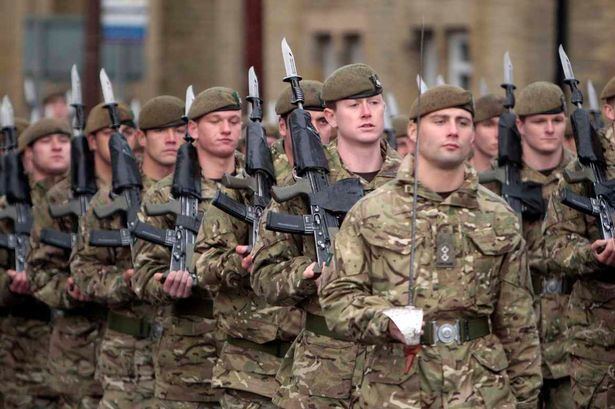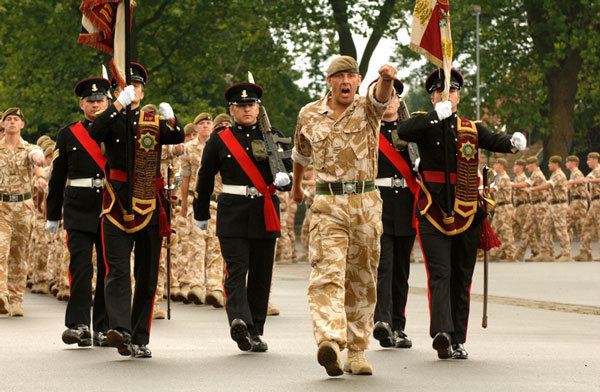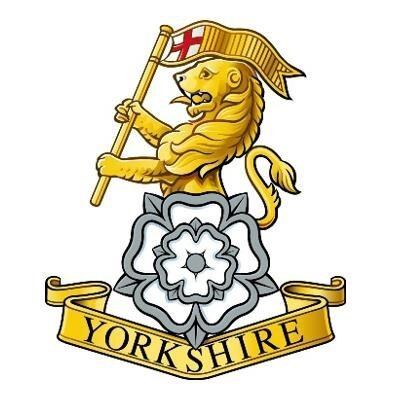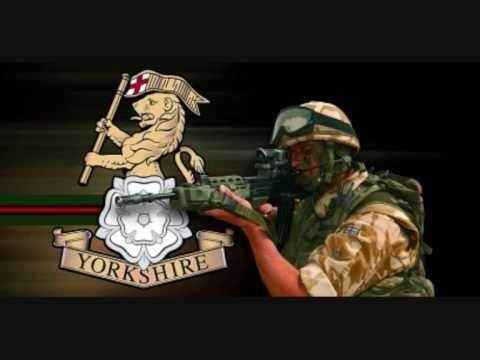Active 6 June 2006 to Present Type Line Infantry Motto(s) Fortune Favours The Brave Size Three battalions | Allegiance United Kingdom Nickname(s) Yorkshire Warriors Branch British Army Part of King's Division | |
 | ||
Role 1st Battalion – Armoured Infantry
2nd Battalion – Light Infantry
4th Battalion – Army Reserve Garrison/HQ RHQ – York
1st Battalion – Battlesbury Barracks, Warminster, England
2nd Battalion – Somme Barracks, Catterick Garrison
4th Battalion – Worsley Barracks, York Mascot(s) 1st Battalion –Indian Elephant; 2nd Battalion – Ferrets (Imphal & Quebec) March Quick – Ça Ira; Slow – The Duke of York Colonel-in-Chief Deputy Colonel-in-Chief The Duke of York; The Duke of Wellington | ||
a ira quick march of the yorkshire regiment
The Yorkshire Regiment (14th/15th, 19th and 33rd/76th Foot) (abbreviated YORKS) is an infantry regiment of the British Army, created by the amalgamation of three historic regiments in 2006. It is currently the only line infantry or rifles unit to represent a single geographical county in the new infantry structure, serving as the county regiment of Yorkshire. It lost one battalion as part of the Army 2020 defence review.
Contents
- a ira quick march of the yorkshire regiment
- The duke of york slow march of the yorkshire regiment
- Formation
- Lineage
- Iraq 20062007
- Afghanistan 20072008
- Kosovo 20082009
- Iraq 20082009
- Afghanistan 20092010
- Afghanistan 20112012
- Kenya 2013
- Regimental Battalion changes July 2013
- Iraq 2014
- 1st Battalion abbreviated 1 YORKS
- 2nd Battalion abbreviate 2 YORKS
- 4th Battalion abbreviated 4 YORKS
- Yorkshire Regiment beer
- Freedom awards
- Battle honours
- Alliances
- References

The regiment's recruitment area today covers almost all the historic county (the three ridings of the county: East Riding of Yorkshire, North Riding of Yorkshire and West Riding of Yorkshire) except for the eastern half of South Yorkshire and the southeast of West Yorkshire, which is a recruitment area for the Rifles, and the part of the West Riding that is now in Greater Manchester. The recruitment area covers all of the present-day ceremonial counties of North Yorkshire (which extends to the northern border of historic Yorkshire — the River Tees) and East Riding of Yorkshire. Recruitment however is open to those from outside the formal recruitment area, with the regiment in particular recruiting from North East England and the Commonwealth.

The regiment's antecedent units also recruited in areas that are now part of Northumberland, Tyne and Wear, Cumbria, Lancashire and Greater Manchester.

The duke of york slow march of the yorkshire regiment
Formation

The regiment's formation was announced on 16 December 2004 by Geoff Hoon and General Sir Mike Jackson as part of the restructuring of the infantry – it was formed from the merger of three regular battalions, plus a reserve battalion:

The regiment was officially formed on 6 June 2006. The reserve "Territorial Army" (as it was then known) battalion re-badged in TA Centres on the same day, but later paraded publicly to re-badge in York on 10 June 2006 in the Museum Gardens, York. That same afternoon representatives of the affiliated Army Cadet Forces and Combined Cadet Forces detachments (approx 50) rebadged in Imphal Barracks, York.
HRH the Duke of York KG was appointed Colonel-in-Chief and His Grace the 8th Duke of Wellington KG LVO OBE MC DL the Deputy Colonel-in-Chief, by HM the Queen.
The four battalions of the regiment were presented with new Queens and Regimental Colours at a parade in Imphal Barracks, York, to replace the antecedent regiments former colours, on 18 June 2010. The 'Honorary' set of Colours carried by the 3rd Battalion (Duke of Wellington's) was paraded by the battalion. The new colours of all four battalions were later paraded through the streets of York from Cliffords Tower to York Minster.
As part of the Army 2020 reorganisation, in July 2012 an announcement was made that the Yorkshire Regiment would be reduced to two regular battalions, with the 2nd Battalion (Green Howards) disbanded and its soldiers dispersed to the remainder of the regiment on completion of their Cyprus tour in the autumn of 2013.
However, on 25 January 2013 the Colonel of the Regiment, Major General Graham Binns CBE DSO MC, announced instead a change in the order of battle as follows: The 2nd Battalion was merged into the 1st & 3rd Battalions. The 1st Battalion was then renumbered as the 2nd Battalion and the 3rd Battalion was renumbered as the 1st Battalion. He also announced that they would dispense with the antecedent regiments' historical titles.
Lineage
The history of the 4th Battalion clearly shows the changing attitudes over the last 40 years, toward the links between regular army battalions and Territorial Army (TA) battalions. The 1966 Defence White Paper dramatically reduced the number of TA units. The effect of this in Yorkshire was the amalgamation of the territorial battalions of the Yorkshire infantry regiments into a single regiment, the Yorkshire Volunteers, created in 1967, that was no longer affiliated with any of the regular army regiments. The Yorkshire Volunteers continued in existence until 1993 when it was disbanded. The driver for disbandment was the 1990 defence review, Options for Change which recommended that the link between TA units and regular units be reintroduced.
The 1997 Strategic Defence Review again cut the size of the TA. As far as the Yorkshire regiments were concerned this involved not only the Yorkshire TA infantry battalions but the TA battalions of the Kings Own Yorkshire Yeomanry and the Royal Regiment of Fusiliers. Too big to be amalgamated into one unit, they were instead split into two units; The East and West Riding Regiment covering those regiments covering the historical geographic areas of York, and the East and West Ridings of Yorkshire,
Barely five years later a further defence review Delivering Security in a Changing World concluded that a new infantry structure, that was geographically based and included both regular and territorial units in the same structure, was required.
Iraq 2006–2007
The deployment of 1 YORKS (Prince of Wales's Own) Battle Group to Basra, Iraq in November 2006 was the first major operational deployment for the Yorkshire Regiment. A Company, under command of Major Richard Hall were based initially in Basra Palace with responsibility from Abu Al Kasib to the whole Al-Faw Peninsula, before moving to Shaibah Logistics Base and being charged with handing over security responsibilities of the base to the Iraqi Army. B Company, under command of Major Dan Bradbury, were based in Shiaba Logistics Base and had responsibility for Az Zubayr, whilst C Company were detached to 2nd Battalion, Duke of Lancaster's Regiment in the COB. During Op Telic 9 Private Luke Simpson of A Company, from Howden, East Riding of Yorkshire, was killed, becoming the 1st Battalion (Prince of Wales's Own) and the Regiment's first operational fatality. Two members of the 1st Battalion (Prince of Wales's Own), Major Ian Crowley of C Company, of Beverley, East Riding of Yorkshire and Captain Ibrar Ali of A Company, were awarded the Military Cross.
Afghanistan 2007–2008
The 2nd Battalion (Green Howards) of the regiment were deployed to the Helmand Province of Afghanistan in September, 2007 in an 'Operational Mentoring and Liaison' role with the Afghan National Army. Whilst there they took part in the Battle of Musa Qala during which Sgt Lee Johnson was killed shortly after 10am on 8 December 2007, in the lead up to the operation to retake the town from the Taliban forces, after his Vector armoured vehicle ran over a landmine. Sgt Johnson had previously received a MID for assisting his Company commander, Major Jake Little, to extract soldiers who were surrounded by Taliban fighters. Major Little was later awarded a Military Cross for his "inspirational leadership" to extract his men. Acting Sergeant John Cockburn was also awarded a Military Cross for his actions in the same tour of duty.
The 2nd Battalion (Green Howards) returned to their barracks in Weeton, Lancashire during April, 2008 and were presented with their service medals at a parade there on 30 April 2008 by Major General Andrew Farquhar, Honorary Colonel of the Battalion, along with Brigadier Andrew Mackay, of 52 Infantry Brigade, and Brigadier Mike Griffiths, of 42 (North West) Brigade.
Kosovo 2008–2009
B Company Group of 1st Battalion (Prince of Wales Own) deployed for six-months on Op OCULUS(K) as the last UK Intelligence, Surveillance & Reconnaissance Task Force (ISR TF). They presided over the immediate aftermath of the Kosovo's declaration of independence.
Iraq 2008–2009
In November 2008, elements of the 1st Battalion (Prince of Wales's Own) redeployed to Iraq on Op Telic 13. In May 2009, 'A Company' of the 1st Battalion (Prince of Wales Own) handed over their Iraq British military HQ protection duties, in Baghdad, to Alma Company of the 3rd Battalion (Duke of Wellington's). Alma Company were subsequently amongst the last British soldiers to leave Iraq at the end of July 2009.
Afghanistan 2009–2010
Over 90 members of the 3rd Battalion (Duke of Wellington's) deployed in August 2009 as Battle Casualty Replacements to various other British regiments in Helmand Province. Burma Company of the 3rd Battalion (Duke of Wellington's) deployed to Afghanistan in August 2009 and were then followed by members of Corunna Company. 18-year-old Pte Jonathon Young, of Burma Company, who was attached to the 2nd Battalion of The Rifles, was killed by an Improvised explosive device in Sangin, on Thursday 20 August, three weeks after arriving in Afghanistan. A serjeant, from the 2nd Battalion The Rifles, 29-year-old Serjeant Paul McAleese, was killed when he went to the assistance of Pte Young.
On 1 February 2010, 22-year-old Corporal Liam Riley, of Sheffield, and 27-year-old Lance Corporal Graham Shaw, of Golcar in Huddersfield were killed by separate IED's, Malgir, near Gereshk in Helmand Province, whilst on base security foot patrols. Both soldiers, from Corunna Company of the 3rd Battalion (Duke of Wellington's), were attached to the 1st Battalion Coldstream Guards, as Battle Casualty Replacements. Prince Harry had trained with Cpl Riley at Suffield in Canada and paid tribute to him in a news release.
The 2nd Battalion (Green Howards), plus 60 members of the 4th Battalion, deployed with 11th Light Brigade in September 2009 for a seven-month posting in Op Herrick XI as the OMLT Battle Group. Their actions featured in a series of Newsnight programmes shown both during the deployment and after their return, which focused on OMLT 2 in Sangin under Major Rob Palfrey. Two members of the Battalion were awarded the Military Cross, Lieutenant Colin Lunn of Doncaster, and Acting Corporal Andrew Wardle of Hetton-le-Hole in Sunderland. In addition, Sergeant John Swithenbank and Corporal John Hardman received the Queen's Gallantry Medal.
On 23 June 2010, 26-year-old Lance Corporal David Ramsden of Otley, who was serving with the 1st Battalion The Mercian Regiment, was killed. The NCO from 1st Battalion (Prince of Wales Own) was serving as part of the Police Advisory Team which was tasked to respond to an incident at a checkpoint near Gereshk in Helmand Province, when the Ridgeback armoured vehicle he was travelling in rolled into a waterway. He was killed alongside colleagues Colour Sergeant Martyn Simon Horton, Private Douglas Niall Halliday and Private Alex Isaac.
Afghanistan 2011–2012
In October 2011, 500 members of the 1st Battalion (Prince of Wales Own) were deployed to Helmand province in Afghanistan for a six-month tour in support of the 20th Armoured Brigade, their first deployment to Afghanistan as a complete battalion. The battalion was split up for the deployment, with A Company working with 3rd Battalion The Royal Regiment of Scotland, B and C Companies with the Danish Army, and the Brigade Headquarters providing staff for Headquarters Task Force Helmand. 1 YORKS soldiers formed the Brigade Reconnaissance Force with members of 1st The Queen's Dragoon Guards. Soldiers from 1st Battalion were reported to have been involved in 'high tempo' patrol operations alongside the Afghanistan police force. B Company serving as part of the Danish Battle Group in the Nahr-e Saraj (North) area of operations, patrolled aggressively into several contested areas. On 1 December 2011 the Battalion was involved in a dawn raid on a suspected IED factory. On 1 January 2012 Private John King was killed in an explosion while on a foot patrol in Nahr-e Saraj, on 27 January Lance Corporal Gajbahadur Gurung of the Royal Gurkha Rifles was killed while serving with 1 YORKS in the Nahr-e Saraj district.
On 6 March 2012, six members of Corunna company, 3rd Battalion (Duke of Wellington's) were killed in the Lashkar Gah Durai region after their Warrior Armoured vehicle was struck by an improvised explosive device.
On 29 April 2012, the 3 YORKS Battle Group took over responsibility of Nahr-e Saraj (South), Helmand province from the 5th Battalion, the Rifles. On the 3 June 2012 Private Gregg Thomas Stone of 3 YORKS Burma Company was killed in Nahr-e Saraj during an operation to apprehend a group of insurgents who had abducted a member of the Afghan Police. On 16 September 2012, Sergeant Gareth Thursby and Private Thomas Wroe of the 3rd Battalion were killed in Nahr-e Saraj by a rogue Afghan police officer.
Kenya 2013
In February 2013 16 soldiers, serving with the 1st Battalion (Prince of Wales Own) Reconnaissance platoon, staged a mutiny whilst on a training exercise in Kenya. Led by Corporal Anthony Brown they staged a sit down strike in front of 1,000 people. Each soldier refused to stand up when individually commanded to do so. As they went through their drills, a ringleader shouted 'sit down' and the dissenters dropped to ground. Commanders ordered each man in turn to stand up but were ignored. The soldiers had clashed with their newly appointed commanding officers who they accused of excessive drinking, complaining they were "being led by muppets". At a Courts Martial, in December 2013, the soldiers pleaded guilty to disobeying a lawful command. Cpl Brown was sentenced to 60 days imprisonment and a dishonourable discharge. The prosecutor Col Whitwham said: 'There was a feeling they were not being appreciated, that they were not being well managed. 'The platoon was said to have worked well in Afghanistan. There was said to have been a perception that they had got a little too big for their boots.' While the soldiers defence Jonathan Lynch, said: 'This is not a case of inflated egos but a case of mismanagement.' Two Lance Corporals were reduced to the rank of Private, with 60 days imprisonment and the Private soldiers were each given 40 days imprisonment.
Regimental Battalion changes, July 2013
The 3rd Battalion (Duke of Wellington's) laid up its Regulation Colours on 20 July 2013, at Halifax Minster, following a series of 'Freedom Parades' during the preceding week. On 25 July there was a parade at the 3rd Battalion barracks, in Warminster, the Colonel in Chief, HRH The Duke of York, exchanged the Colours between the Battalions. The 1st Battalion Colours were handed over to the new Warminster Battalion '1 YORKS' and the third Battalion's Honorary Colours (76th Regiment of Foot) were handed over to the new 2nd Battalion, '2 YORKS'. The Honorary Colours will be retained, annually, by each battalion for one year.
Iraq 2014
In October 2014 the UK Ministry of Defence confirmed that a team of about a dozen soldiers from the Yorkshire Regiment's 2nd Battalion were training Kurdish forces in Iraq fighting Islamic State militants to use UK-supplied heavy machine guns.
1st Battalion (abbreviated 1 YORKS)
The 1st Battalion is based at Battlesbury Barracks in Warminster. The battalion is an armoured infantry battalion deployed as part of 12th Armoured Infantry Brigade.
2nd Battalion (abbreviate 2 YORKS)
The 2nd Battalion, is based at Somme Barracks at Catterick Garrison. The battalion is a light mechanised infantry battalion deployed as part of 4th Infantry Brigade and Headquarters North East.
4th Battalion (abbreviated 4 YORKS)
The 4th Battalion, serving as reserve infantry is the Army Reserve battalion of the Yorkshire Regiment. The battalion headquarters is in Worsley Barracks, York and forms part of 4th Infantry Brigade and Headquarters North East. The battalion operates from Army Reserve Centres across the regimental footprint with companies dispersed in Barnsley, Beverley, Huddersfield, Hull, Leeds, Middlesbrough, Scarborough, Sheffield and York.
Yorkshire Regiment beer
On St George's Day 23 April 2008, Paul and Phil Lee, the owners of the Cropton Brewery & New Inn, released a new beer called Yorkshire Warrior. The beer, which is only available in eight North Yorkshire pubs, was produced to celebrate the proud achievements of the regiment and to commemorate the sacrifices the soldiers and families of the regiment have endured. The information on the bottle label states that the full proceeds of the beer sales go directly to the regimental benevolent fund to help support those regimental members who require help following their discharge from the service.
Freedom awards
Freedoms awarded to the Yorkshire Regiment including those carried through from the antecedent regiments include the following:
The regiment also holds the distinction of having the freedom of Erquinghem-Lys, France. This was passed on from the freedom awarded to the 3rd Battalion (Duke of Wellington's) in November 2005. The Duke of Wellington's Regiment (West Riding) were also awarded the Freedom of Mossley, on 8 July 1967.
On 3 August 2009 Rotherham became the first town to bestow the 'Freedom of the Borough' on the Yorkshire Regiment. This gives the regiment the right to march through the town with 'flags flying, bands playing and bayonets fixed'. At a ceremony outside the Town Hall the Regiment paraded two Guards of soldiers, who had recently returned from Iraq and the Colours of the 3rd Battalion Yorkshire Regiment (Duke of Wellington's), led by the Kings Division Band, under the command of Lieutenant Colonel Vallings, the Battalion Commanding officer. The Mayor of Rotherham, Councillor Shaukat Ali, on behalf of the Borough, presented the Freedom Scroll to Colonel Simon Newton, who accepted the honour for the Regiment. The regiment was the first military unit to become 'Honorary Freemen of the Borough.
On 8 September 2013 the regiment was given the Freedom of Barnoldswick, in Lancashire during a rededication ceremony of the town War Memorial, when 46 new names from the two world wars were added.
The Yorkshire Regiment was awarded the Freedom of Warminster on its return from Afghanistan following their Homecoming Parade on 30 November 2013.
Battle honours
Including those inherited from preceding units
Infantry regiments are permitted to display 43 battle honours from the two world wars on the Queen's Colour and 46 honours from other conflicts on the Regimental Colour. Upon amalgamation, the Yorkshire Regiment had to choose from the total list of honours of its three antecedents which honours would be displayed on its new colours. The chosen honours were:
In addition to the displayed honours, the regimental colours also display four emblems from the antecedents regiments:
The Battalion's Roman Numeral is in the top left corner of each flag. The use of the Cross of St George as the background is unique to the Yorkshire Regiment.
